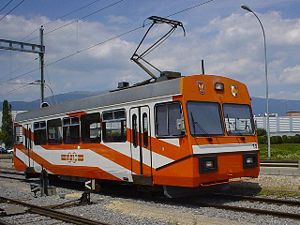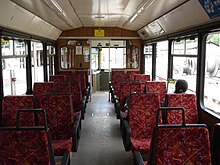OC Be 2/2
| OC Be 2/2 | |
|---|---|
| Numbering: | OC 14 Travys 557 614 |
| Number: | 1 |
| Manufacturer: | Stadler |
| Year of construction (s): | 1990 |
| Axis formula : | Bo ' |
| Gauge : | 1435 mm ( standard gauge ) |
| Length: | 13,340 mm |
| Empty mass: | 20.2 t |
| Wheel set mass : | 10.1 t |
| Top speed: | 80 km / h |
| Hourly output : | 360 kW |
| Power system : | 750 volts DC |
| Power transmission: | Overhead line |
| Number of traction motors: | 2 |
| Seats: | 40 |
OC Be 2/2 is the type designation of a two-axle, standard-gauge electric multiple unit from Chemin de fer Orbe-Chavornay (OC). The railcar was manufactured by Stadler , and as a Travys vehicle it is now numbered Be 557 614.
history
In the fall of 1986, the company submitted a loan application to the responsible authorities to purchase a new locomotive. At that time, their approximately seventy-year-old wooden box motor vehicles BDe 4/4 12 and 13, which no longer met the needs of the passengers, had to be replaced. The consideration of the procurement of a German rail bus , which was to be equipped with the electrical equipment of a trolley bus , did not lead to the goal. Since no other suitable used vehicle could be found for the almost four-kilometer-long route electrified with 750 volts direct current , the only option was to build a new one.
Although postbus lines operate to Orbe as well as to Chavornay , which could have taken over passenger traffic in the form of line extensions, there have never been any concrete plans to convert passenger traffic to buses . This was because the infrastructure was in good condition , also because of the heavy freight traffic . The financial requirements for the continuation of the regional passenger transport were thus limited to the running vehicle and personnel costs, the costs for the infrastructure could be neglected. Because the company also did not want to forego the income from passenger traffic, it procured the one-off in 1990 for around one million Swiss francs .
The then still small company Stadler was the only company active in the field of railway vehicle construction that tried to win the order. It was the first vehicle that Stadler built after it was taken over by Peter Spuhler , and it was Stadler's first ever passenger railcar.
description
The railcar is designed for one-man operation and as a single driver has neither a coupling nor a buffer . There is, however, a tow hook, with the bezels of the headlights serving as emergency buffers. The electrical equipment was supplied by Asea Brown Boveri . The motors are controlled by a conventional hopper control . There is a special speed monitoring device installed, which monitors the entry speed into the terminal stations. This is supplemented with an automatic lowering device for the pantograph of the locomotive. This prevents an OC vehicle in Chavornay with a raised pantograph from being able to enter the shared track - which has a switchable overhead contact line .
commitment
From 1990 to 2006, the railcar served almost exclusively all traffic on its main route. The predecessor vehicles BDe 4/4 12 and 13 were still used as reserve vehicles and for extra trips. As a result of the increased traffic volume, a Uetlibergbahn railcar (formerly SZU BDe 576 513) and a control car (formerly SZU Bt 912) were adapted by Stadler Rail for the OC. This has since been referred to as BDe 4/4 15 (Travys BDe 557 615) and arrived at the OC on October 14, 2006. Since 2007, the BDe 4/4 15 has carried most of the scheduled trains, while the Be 2/2 14 serves as a reserve.
literature
- Matthias Huber: New Spring on the Orbe – Chavornay Railway , published in Swiss Railway Review 11/1990 , pages 333–340

